

Penmachine
29 November 2008
Better start from the start
 My
daughters, like most people, have different talents. My youngest, L,
can turn cartwheels, hang from jungle gyms, and balance on those
one-wheeled rolling sneakers known as Heelys
like nobody's business. (Sometimes you're certain she'll crash
catastrophically into someone or something, but she'll simply swerve
nonchalantly out of the way.) I can't do any of those things, and
neither does anyone else in our family.
My
daughters, like most people, have different talents. My youngest, L,
can turn cartwheels, hang from jungle gyms, and balance on those
one-wheeled rolling sneakers known as Heelys
like nobody's business. (Sometimes you're certain she'll crash
catastrophically into someone or something, but she'll simply swerve
nonchalantly out of the way.) I can't do any of those things, and
neither does anyone else in our family.A few weeks ago, she said "hey, watch this!" to her mom and me. Before we knew it, she was suspended in mid-air in our kitchen doorframe, legs braced against the sides. Zoop, up she'd gone, Spider-Man style.
Her sister, M, has an ear for music. Yes, she can carry a tune—they both take music lessons, but it was M who begged us for them five years ago. Here's her example. A few weeks ago we saw one of those "where are they now?" shows on TV, this one featuring Mike Reno of Loverboy, who lives here in Vancouver. Then, a few days ago, I was at a restaurant with my kids and our friend Paul and his family. M cocked her head and said to me, "Hey, is that that Mike Reno guy singing?" I listened, but could hardly make out any music on the sound system over all the noise of people jamming the restaurant.
Then, sure enough, in a quiet spot, there it was: "Workin' for the Weekend," barely audible but undoubtedly there. She'd heard a little part of it once, it stuck there in her brain, and she filtered it out of the background automatically. How many ten-year-olds can identify a snippet of Loverboy (?!) at 20 paces, and name the singer?
As a boastful dad proud of his daughters' good taste, I also have to tell you that on sick days home from school, L spontaneously gives herself math lessons out of books (her mom is a math teacher). And when M redecorated her room this summer, she insisted on covering the walls with Beatles posters (wonder where she got that?).
28 November 2008
Practical extravagance
 If
money were no object, I wouldn't be one to buy a fancy car or a
mansion—I'd get something good in each case, but also something
practical. It's the same with cameras.
If
money were no object, I wouldn't be one to buy a fancy car or a
mansion—I'd get something good in each case, but also something
practical. It's the same with cameras.I've used Nikon's top-end D3, and it's a fine instrument, but far more camera than I'd need. The D3x, just mistakenly announced today, would be even further overkill. Never mind the various medium format cameras and the upcoming ultra-luxe Leica S2.
So, if I were suddenly independently wealthy, I'd still get myself a new Nikon, but it would be the D700, which packs most of the power of the D3, including its wonderful low-noise, high-sensitivity full-frame sensor, into a smaller (we're talking relatively smaller here) package. I've also tried the similarly sized D300, so I think the D700 would fit better in my hand.
And I'd buy some great lenses too, of course, because that's where money is best worth spending. I'm still using an inexpensive but quality lens I bought in 1995, while the camera it went with is long, long gone.
Finally, I'd travel to beautiful places with my family, to make photos with them.
27 November 2008
Conan O'Brien beats all guitar shredders
Andy Baio links to a brilliant set of videos, featuring famous guitarists playing their own songs
in Rock Band. Most aren't very good, because it's hard to play fake
guitar when you know how to play the real thing—and especially when you wrote the song.
The funniest bit, though, is the link in the comments to Conan O'Brien rapping the Beastie Boys' "Sabotage" in the voice of Edith Bunker. It's a laff riot.
The funniest bit, though, is the link in the comments to Conan O'Brien rapping the Beastie Boys' "Sabotage" in the voice of Edith Bunker. It's a laff riot.
26 November 2008
My favourite new word
The latest issue of National Geographic is, as usual, excellent, but my favourite bit of it is a new word. In Spanish, the word chatarra means "scrap," but it's also slang in Mexico for "junk food."
I think it could be a great word in English too: "Oh, those pork rinds are total chatarra."
I think it could be a great word in English too: "Oh, those pork rinds are total chatarra."
25 November 2008
My crazy new mutant eyelashes
Back at the beginning of this year, the chemotherapy treatments I received made my hair thin and grey. My eyelashes similarly thinned out almost to unrecognizability. But I'm on a different chemo regimen now that doesn't make me shed hair, so check them out now...
I had shaved my head in March because of the annoyance. It has grown back very slowly, but now it's back and dark again. I didn't trim my lashes: they just fell out. What's weird is they have come back at a bizarre fluffy mutant length, like I'm wearing a ton of mascara.
Raul asked, "Do they feel different? e.g. do you have any particular sensitivity around the hair follicles?" Not there, but when I blink, they now brush against the lenses of my glasses, which is a strange feeling. And I can see them—another change.
Although they have been pretty long most of my life, my eyelashes have never looked anything like this before. But I've gotten used to them, and most of the time I don't notice the difference unless I look in the mirror. Check out my Brezhnev eyebrows too. Those are going to need a trim.
I had shaved my head in March because of the annoyance. It has grown back very slowly, but now it's back and dark again. I didn't trim my lashes: they just fell out. What's weird is they have come back at a bizarre fluffy mutant length, like I'm wearing a ton of mascara.
Raul asked, "Do they feel different? e.g. do you have any particular sensitivity around the hair follicles?" Not there, but when I blink, they now brush against the lenses of my glasses, which is a strange feeling. And I can see them—another change.
Although they have been pretty long most of my life, my eyelashes have never looked anything like this before. But I've gotten used to them, and most of the time I don't notice the difference unless I look in the mirror. Check out my Brezhnev eyebrows too. Those are going to need a trim.
24 November 2008
By the river of Albion
I've lived in the Vancouver area my whole life, but somehow I had never been on the Albion Ferry, which crosses the Fraser River east of the city.
Today I rectified that. My kids have been on the ferry several times
with my in-laws, so they showed me how to get there and how it works
(they had the day off from school). It's a short trip, only a few
minutes, but it has a fantastic view:
From the Maple Ridge side of the river, the boat takes you to the village of Fort Langley, where the province of British Columbia (then a British colony) was born 150 years ago this month. There the girls and I had lunch, and I bought them some stylish new hats.
The Albion Ferry route will soon be replaced by the Golden Ears Bridge, nearing completion slightly further downstream, ending the 51-year run of ferryboats there on the river. Some people want to save the Albion Ferry, but I don't think that's likely to happen. So my first trip might also be my last.
From the Maple Ridge side of the river, the boat takes you to the village of Fort Langley, where the province of British Columbia (then a British colony) was born 150 years ago this month. There the girls and I had lunch, and I bought them some stylish new hats.
The Albion Ferry route will soon be replaced by the Golden Ears Bridge, nearing completion slightly further downstream, ending the 51-year run of ferryboats there on the river. Some people want to save the Albion Ferry, but I don't think that's likely to happen. So my first trip might also be my last.
22 November 2008
Camera Works: intermediate f-stop values
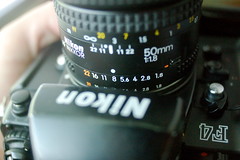 The aperture and f-stops article in my ongoing Camera Works series has been popular, but it has also raised some questions. Here's one from Mike S.:
The aperture and f-stops article in my ongoing Camera Works series has been popular, but it has also raised some questions. Here's one from Mike S.:How much ISO would I gain?
I just read your blog on f-stops. Very informative and I learned things I had given up on. I do have a question. Keep in mind I'm not mathematically inclined. I am trying to figure out how much ISO I would gain, meaning lower ISO, if I shot at a 1.8 setting versus a 2.8? I currently only own 2.8 lenses and find myself shooting indoor sports at ISO 3200 at about a 320th of a second. My goal is to get the ISO to 1600 or lower while keeping the 320 [shutter speed] as a minimum. How would I figure this out? I wasn’t sure if 2.8 was double 1.8.My answer is that lens at f/1.8 does not let in double the light of a lens at f/2.8: it lets in more than that. About 2.4 times as much light, in fact. We'll see why below.
Warning: include(): http:// wrapper is disabled in the server configuration by allow_url_include=0 in /home/thelab1c/public_html/penmachine.com/old/2008_11_01_.php on line 484
Warning: include(http://www.penmachine.com/cameraworks.php): failed to open stream: no suitable wrapper could be found in /home/thelab1c/public_html/penmachine.com/old/2008_11_01_.php on line 484
Warning: include(): Failed opening 'http://www.penmachine.com/cameraworks.php' for inclusion (include_path='.:/usr/lib/php:/usr/local/lib/php') in /home/thelab1c/public_html/penmachine.com/old/2008_11_01_.php on line 484
As I described in that original article in August, the sequence of full stops runs in multiples of 1.4 (actually the square root of 2, which is 1.41421356..., but close enough), so if you start at f/1, you have:
1, 1.4, 2, 2.8, 4, 5.6, 8, 11, 16, 22, 32, 45, 64(You won't see f/45 or f/64 on normal SLR or point-and-shoot lenses, but they're not uncommon on large-format cameras.)
Each of those values lets in half the light of the stop to the left, and twice the light of the stop to the right. So in Mike's case, using a lens that can open to f/2 instead of f/2.8 will let him use either twice the shutter speed or half the ISO (light sensitivity) setting. But what about f-stops that don't fit that sequence, like f/1.8 or f/3.3?
Figuring out intermediate f-stops
This takes simple real-world f-stop math, but it's just multiplying and dividing, so it's not hard. The old area-of-a-circle equation (πr2) gives you the answers:- If you're at f/2.8, the diameter of your aperture is 1/2.8 the focal length of the lens (or about 0.357 the focal length).
- If you're at f/1.8, the aperture is bigger, 1/1.8 (or about 0.556 the focal length).
- The ratio of the two aperture diameters, 0.556 to 0.357, is about 1.56 (just divide 0.556 by 0.357), so f/1.8 is about 1.56 times wider than f/2.8. (You could actually do this more simply: 2.8 divided by 1.8 gives you the same number, about 1.56.)
- From that area-of-a-circle equation, since the area (and the light let through) changes by the square of the diameter (or radius, it doesn't matter in this case) of the aperture, simply square that ratio value (1.562) to get about 2.4.
- So f/1.8 lets in about 2.4 times more light as f/2.8, and f/2.8 lets in about 2.4 times less light than f/1.8.
What does that mean?
Here's how you can use that knowledge:- If you stay at ISO 3200 and it works at 1/320 of a second at
f/2.8, you can shoot 2.4 times faster if you go to f/1.8, which would be
(320 x 2.4) or 1/768 sec (or 1/750, rounded to the nearest realistic
camera shutter speed).
—or— - If you're adjusting ISO and keep the shutter speed fixed, you can shoot at 3200 divided by 2.4, or ISO 1333 (more like 1250 in real-world terms) if you click from f/2.8 to f/1.8.
In the digital age, we now have that third variable, because we can adjust the ISO as much as we want, or even have the camera adjust it automatically for changing lighting conditions, so that each picture can use its own ISO setting, as well as its own aperture and shutter speed.
The simple version
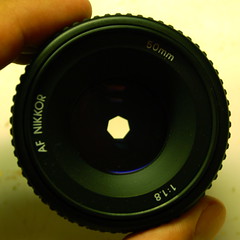 All
right, so here is the simplified version of what to do when you want to
know how two different f-stops affect ISO and shutter speed:
All
right, so here is the simplified version of what to do when you want to
know how two different f-stops affect ISO and shutter speed:Divide the bigger f-stop number by the smaller one (2.8 divided by 1.8, for example) to get the ratio of their diameters. Then square the result to find out the ratio of light let through. Next, multiply or divide your shutter speed or ISO by that value to figure out how you need to adjust it.
Or let your camera's meter figure it out!
The nice part is that while you have to square the aperture ratios to determine how much light is let through, shutter speed and ISO simply multiply or divide by 2: 1/500 sec lets in half the light of 1/250, and ISO 3200 captures twice the light of ISO 1600, so the rest of the math is straightforward
Another example
- I'm at f/3.3 at 1/2000th of a second at ISO 200 and I stop down to f/16 because I want more depth of field.
- 16 divided by 3.3 is about 4.85.
- 4.85 squared is about 23.5, so F/16 brings in 23.5 times less light than f/3.3.
- So I need a shutter speed 23.5 times slower to let in the same amount of light. 2000 divided by 23.5 is about 85.1, so I need 1/85 of a second (or 1/90, rounding off for most cameras) to get the same exposure.
- Or I can adjust the ISO: 200 times 23.5 is ISO 4700, and I can still shoot at 1/2000. I'll need a pretty new, high-end DSLR to get that high an ISO value, but it is possible.
- You can also combine things. If I decide to shoot at 1/1000 of a second, I can halve the ISO to 2350 at f/16, more in the range of regular cameras these days. Many won't let you set the ISO to incremental values like that manually, but they will do it in Auto ISO modes that keep shutter speed and aperture fixed and adjust ISO to match the exposure, as I mentioned above.
One stop can be expensive
People taking sports photos typically use a zoom or telephoto lens with a focal length of 200 mm or so. You can buy a very nice 70-200 mm zoom that opens to f/2.8 from Canon, Nikon, and others for between $700 and $1700 USD. Not cheap, but worth it if that's what you need to do.But if you want a 200 mm lens that opens one stop wider, to f/2? Nikon and Canon make them. They're huge, and will set you back something like $5000. Back in the '80s Nikon even made a 300 mm f/2 lens. List price? $29,000.
Modern digital cameras with good performance at high ISO sensitivity, and lenses with image stabilization, now make it possible to get similar results (one stop faster) for much, much less money.
21 November 2008
Farewell, Mr. PJ
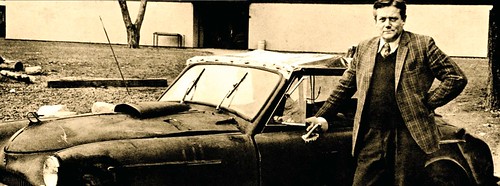 In 1986 I was in the last class of Math 12 students taught by Tony Parker-Jervis, the legendary mathematics teacher, hot-rod enthusiast, and curmudgeon at St. George's School.
He had been on staff there since the '50s or early '60s—and before
that, he had been among the school's first students, graduating in 1935
before going off to war, where he taught himself advanced mathematics
while calculating ballistics trajectories.
In 1986 I was in the last class of Math 12 students taught by Tony Parker-Jervis, the legendary mathematics teacher, hot-rod enthusiast, and curmudgeon at St. George's School.
He had been on staff there since the '50s or early '60s—and before
that, he had been among the school's first students, graduating in 1935
before going off to war, where he taught himself advanced mathematics
while calculating ballistics trajectories.I just received a message that Mr. PJ has died, more than two decades after he retired. Former students like me remember him fondly, though he terrified us at the time. His ruthless high standards and eccentric teaching and testing methods are probably the main reason that I, not a natural mathematician, scored well enough in provincial exams and Euclid contests to take advanced-level freshman math courses at university. (I finally exhausted my capabilities with the brain-bending black art of integral calculus, where I squeaked by with 56%.)
It strikes me as odd now, but seemed natural at a British-style boys' school in the '80s: Mr. PJ spoke with a distinct, growly English accent. That's strange because he grew up here in Vancouver. He also smoked relentlessly, wore chalk-stained tweed jackets (or maybe the same jacket?) every day, and was infamous for keeping underperforming students after school for short tests he made up on the spot. He called them GOWYGIAR—Get Out When You Get It All Right. We pupils could help each other as he sat at his desk or paced the room threateningly, but each of us could only leave when we had answered every question to his satisfaction. Sometimes they were long afternoons.
UPDATE: His British accent is more sensible now that I
know that in addition to being born in Singapore and spending his first
few years on a Malaysian rubber plantation (which I had heard before),
he studied in England after living in Vancouver, before the War (which I
had not). The new details are from his obituary, published in the Vancouver Sun.
Our raw marks in his classes were pitiful, because his tests and
assignments were so hard that all but the most gifted boys routinely
averaged 30 or 40%. But he scaled up our scores by some inscrutable
formula that usually bumped the best marks—maybe as high as 70%!—up to
100%, dragging the rest of us along. He chuckled wryly at that, but he
taught us enough that provincial exams seemed easy.Mr. PJ drove a massive '70s Cadillac, but his secret weapon was an old Austin (British car, of course) that he had souped up himself with a huge V8 engine and bizarre silver paint. Rumours had it capable of well over 150 miles an hour. I'm not sure what he did to the Austin frame to keep it from annihilating itself at such speeds. He no longer brought it to school regularly when I was there, but we did see it occasionally. It merited its own three-page spread in The Dragon (PDF), the school newsletter, as late as last year. The article was simply called "THE CAR," and we all knew what it was talking about.
I hadn't seen or heard from Mr. PJ at all in the past 22 years, and don't even know what he'd been up to. Like other teachers who have died since I left St. George's School, including my old home room teacher Craig Newell this year, he leaves a gap that I didn't realize was there. The influence of teachers, decades later, is remarkable.
20 November 2008
Berlin 1965
For as long as I can remember, my parents have had this photo hanging on their bedroom wall:
I made a copy last night because my younger daughter has a project at school where she's discussing Germany, and she wanted a copy of this picture to illustrate Berlin, where it was taken. It was 1965, on my parents' honeymoon. My mom and dad were 26 at the time, and that's the city's mascot, a bear, between them. Here they are today (without the bear):
My dad still wears collared shirts most of the time, though my mom isn't into the bonnets anymore.
They look young in that first photo. My wife and I were the same age, 26, when we got married 30 years later. We didn't feel so young then, but we were too.
I made a copy last night because my younger daughter has a project at school where she's discussing Germany, and she wanted a copy of this picture to illustrate Berlin, where it was taken. It was 1965, on my parents' honeymoon. My mom and dad were 26 at the time, and that's the city's mascot, a bear, between them. Here they are today (without the bear):
My dad still wears collared shirts most of the time, though my mom isn't into the bonnets anymore.
They look young in that first photo. My wife and I were the same age, 26, when we got married 30 years later. We didn't feel so young then, but we were too.
18 November 2008
Another new song, "In Phase One"
This week I'm spending all day every day at the B.C. Cancer
Agency having my blood tested, blood pressure taken, and ECGs done as
part of the Phase I clinical trial I'm participating in—hence my lack of blog posts.
It's not much fun, but I do have plenty of free time in between tests. I spent most of today sleeping after a mostly sleepless night of intestinal side effects (now much better). But yesterday I was more awake, and spent some of my time taking an old guitar riff I'd recorded more than two years ago and building an actual instrumental tune out of it. The result is:
It's not much fun, but I do have plenty of free time in between tests. I spent most of today sleeping after a mostly sleepless night of intestinal side effects (now much better). But yesterday I was more awake, and spent some of my time taking an old guitar riff I'd recorded more than two years ago and building an actual instrumental tune out of it. The result is:
- "In Phase One" - 3.1 MB MP3 file, about 2 min 20 sec
15 November 2008
The Lions' Gate and Pattullo turn 70
According to Tod Maffin and Buzz Bishop, this week marks the 70th birthdays of both the Lions' Gate Bridge and the Pattullo Bridge here in Greater Vancouver. It would be hard for two bridges to contrast more in their appearance:
The Lions' Gate (connecting downtown Vancouver's Stanley Park with the North Shore across Burrard Inlet) is an elegant suspension bridge, lit at night with glittering lamps, and a beautiful landmark admired throughout the city and the world. It's on many of the city's postcards. It was heavily refurbished a few years ago, but looks the same as it always has.
The Pattullo (connecting New Wesminster to Surrey) is an ungainly girdered structure often cursed by those who must drive its narrow, dangerous lanes. Premier Duff Pattullo, after whom it is named, apparently called it "a thing of beauty." Tod says, "Yes, he was likely stoned." Plans are afoot to knock it down and replace it.
The Lions' Gate (connecting downtown Vancouver's Stanley Park with the North Shore across Burrard Inlet) is an elegant suspension bridge, lit at night with glittering lamps, and a beautiful landmark admired throughout the city and the world. It's on many of the city's postcards. It was heavily refurbished a few years ago, but looks the same as it always has.
The Pattullo (connecting New Wesminster to Surrey) is an ungainly girdered structure often cursed by those who must drive its narrow, dangerous lanes. Premier Duff Pattullo, after whom it is named, apparently called it "a thing of beauty." Tod says, "Yes, he was likely stoned." Plans are afoot to knock it down and replace it.
Still a sexy beast, if a little addled
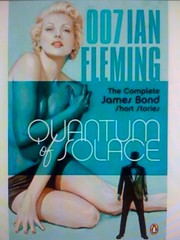 The iconic James Bond "shoot at the camera" montage doesn't appear until the end of Quantum of Solace,
and that's a good summation of the whole movie: it's fun, but things
aren't quite in the right place. In fact, by the time it's over, it
seems a bit like a Bond movie trailer that lasts almost two hours.
The iconic James Bond "shoot at the camera" montage doesn't appear until the end of Quantum of Solace,
and that's a good summation of the whole movie: it's fun, but things
aren't quite in the right place. In fact, by the time it's over, it
seems a bit like a Bond movie trailer that lasts almost two hours.A couple of years ago I raved about Casino Royale, Daniel Craig's first Bond appearance. Quantum isn't as good. It strays too far into Jason Bourne land, where the fights are all dizzying intercuts, the scenes flit around the world almost randomly (Italy, Britain, Haiti, Austria, Bolivia, Russia...), and the various secondary players are so corrupt that there's nearly no one left to root for. There's something emotional missing, and by the time it's over you wonder a little what most of the movie had to do with Bond's end goal.
I'm not saying I didn't like the film. Craig remains extraordinary in the role, steely and taut. There's a lot of clever editing, implying what happens rather than showing it. The action scenes—including chases on foot, in boats, in cars, and on aircraft—spark with energy, even if they occasionally confuse. By the end, you know more about why Bond is who he is, and there's a nice little joke about Canadians, presumably by Canadian lead writer Paul Haggis. Overall, my wife and I enjoyed it.
But next time, the filmmakers need to go back to Casino Royale and figure out why that movie didn't just spark, but was refreshingly, blazingly on fire. They have a good thing going, but they've got to keep it going.
14 November 2008
Today, it's Japan, China, and India at the Moon
 Remember when the U.S. and Russia were the only countries with space programs and their own rockets? Then came the European Space Agency, mostly launching commercial satellites from French Guyana. Somehow my 1970s kid brain is still stuck in that mindset.
Remember when the U.S. and Russia were the only countries with space programs and their own rockets? Then came the European Space Agency, mostly launching commercial satellites from French Guyana. Somehow my 1970s kid brain is still stuck in that mindset.But it's wrong, wrong, wrong. Yes, the U.S. still sends plenty of astronauts into orbit, and has wonderful robotic probes venturing throughout the solar system. But how about the Moon? As far as I can tell, the last time America sent anything to the Moon was ten years ago, when the Lunar Prospector orbited, then intentionally crashed into a crater to test for water. Russia hasn't sent anything since the Luna 24 probe in 1976. The ESA was there more recently, with its SMART 1 five years ago.
Who is sending spacecraft to the Moon now? That would be Japan, China, and (most notably today) India, which hit the moon with a flag-painted impact probe sent from its Chandrayaan-1 lunar orbiter mere hours ago.
The U.S. has a lunar orbiter scheduled to launch next year, and both it and Russia have grand plans to send people back, but for now, it is the countries of Asia that are telling us about our nearest neighbour in space. I think that's pretty cool.
12 November 2008
"Pepper Plant" and "Spokesmodel Six Eight," my two new songs, plus the archive
For the past two and half years, I've been using Apple's iWeb to publish my Penmachine Podcast
of original free MP3 music, interviews, and such. It's always been a
pain to use, especially when the files aren't hosted on Apple's
.Mac/MobileMe service (which mine aren't), but I kept working with it
out of inertia and because it was worth knowing how iWeb works, as well
as because I don't update that podcast very often anyway.
But earlier this year, Apple went and broke iWeb for podcasting, and seems in no hurry to fix it. So while I figure out how to migrate my podcast over to some other platform (probably WordPress, but we'll see), I'm just going to post the two new songs I have for it here. I'll add them to the Podsafe Music Network soon too.
But earlier this year, Apple went and broke iWeb for podcasting, and seems in no hurry to fix it. So while I figure out how to migrate my podcast over to some other platform (probably WordPress, but we'll see), I'm just going to post the two new songs I have for it here. I'll add them to the Podsafe Music Network soon too.
New songs
Each link goes directly to the MP3 file for the song, so right-click or control-click to download it instead of playing it in your browser. Unless noted otherwise, all MP3s linked from this post are available under a Creative Commons Attribution 2.5 license. Use them as podcast theme music, backgrounds, or remix them, or whatever—just give me credit:- "Pepper Plant" (4.3 MB MP3 file) - Of course I've been working on new songs and speaking and going on the radio since March, but I've been too lazy to update the podcast. No more. Here is "Pepper Plant", an instrumental tune I finished in October 2007, but thought I would add to, or at least remix. Yet somehow I never did. Listening to it again, it sounds just fine, so I figured I'd post it up. I'd describe it as something like an old Booker T and the MGs instrumental tune, though not quite as groovy. Give it a listen and see what you think.
- "Spokesmodel Six Eight" (2.9 MB MP3 file) - Earlier in 2008, I borrowed a set of MIDI electronic drums from our friends KA, Jeff, and Clive. "Spokesmodel Six Eight" emerged from using that kit: its name comes from the 6/8 time signature I chose to play it in, since that's something not easy to find in the built-in drum loops for GarageBand. It's another track I expected to finish off, polish, and remix at some point, because it's nothing but drums and some guitars. No bass, no keyboards, no vocals, hardly any arrangement there at all. But it doesn't need more than that, and I particularly like the sounds of the guitars I managed to obtain. So rock out with it.
Old songs
As a bonus, here are all the free MP3 songs (again, mostly instrumental) I've published to the podcast since I started in 2004, in semi-alphabetical order. Tracks with an asterisk * are also available on my album Penmachine Sessions from 2005:- All Blues Jam with Doug Kaye and Dave Dederer (not Creative Commons, all rights reserved)
- Alpaca Cheese
- Amarilli Mia Bella by Simon James
- The Burning Moon with Simon James*
- Camp Walk
- Can You Dig It? - Business Jive theme
- Clouds or Smoke?*
- Cold Cloth and an Ice Pack*
- Comcast Connection Blues - words by Chris Pirillo
- Deep Cycle Discharge with Simon James*
- El Campo
- Fakeout
- The Flu Song Medley from my band in 1994 (Creative Commons Music Sharing license)
- Fresh Snow in the Valley*
- Funkly Dougietude with Doug Elliott
- Gronk Patrol*
- Had a Plan, Had to Change It*
- Hotcake Syrup*
- How Tall Jennifer Is*
- In the Hollow - Stars Hollow Podcast theme
- It Wouldn't Hurt - 2001 demo
- Less Red Than Red - now the theme for Windows Weekly
- More Red Than Red
- Marina Bay (original master)
- Marina Bay (remaster)
- Meltdown Man* - appearing in the documentary film Paper or Plastic?
- Mighty Mullane (full version)
- Mighty Mullane (short version)
- Pirilloponzi with Chris and Ponzi Pirillo* (Creative Commons Music Sharing license)
- P and P
- Pissed Off Adam Curry (full version)
- Pissed Off Adam Curry (short version)
- A Pizza Without Time
- Pocketbook*
- Quick 'n' Dirty Drums - released to the public domain
- Stop Yield Go Merge*
- Stop Yield Go Merge (Les Thorn remix)
- Striking Silver - 12 minutes!
- Take Time for the Tub
- Tell Me About Gnomedex (full version)
- Tell Me About Gnomedex (instrumental version)
- Tell Me About Gnomedex (karaoke version)
- That's No Dream*
- Washing Off Like an Aardvark (full version) - later the theme for The Planet TV Show
- Washing Off Like an Aardvark (short version)
- Washing Off Like an Aardvark (shorter version)
- Washing Off Like an Aardvark (stub version)
- We Three Kings - Christmas tune
- You're the Big Sky (vocal version)
- You're the Big Sky (instrumental)
11 November 2008
Soggy fields on a sombre day
 It's miserable, sloppy, rainy November day here in Vancouver. It often is on Remembrance Day, and that's appropriate. Soldiers die on all sorts of days—sunny, rainy, snowy, windy, or calm—but this weather fits the mood.
It's miserable, sloppy, rainy November day here in Vancouver. It often is on Remembrance Day, and that's appropriate. Soldiers die on all sorts of days—sunny, rainy, snowy, windy, or calm—but this weather fits the mood.We used to know it as Armistice Day, to commemorate the end of World War I, which we used to know as the Great War. But the holiday has once more come to have greater meaning in recent years, as our soldiers die in distant wars again. It's no longer a remembrance of history alone—the veterans and their families are no longer exclusively old. Sure, I fight my own battle with cancer, and with death, but when I see the names and faces of Canadians killed in Afghanistan, and think of Afghans dying there too, I consider how young many of them are, just as their predecessors were overwhelmingly young.
Most are much younger than me, never having had a chance to age or get ill. Just gone early, from bullets or bombs, gas or grenades.
Today isn't a glorious day, but a sombre one. Our yards and cemeteries are puddled and muddy, like those battlefields so regularly were—and are. That helps me remember.
10 November 2008
Treatments and repairs
A few weeks ago I was contemplating skipping my next clinical trial of cancer treatments, but after talking to my doctors it seems that the drug under examination, cediranib,
has a better potential for being effective, and is less likely to cause
nasty side effects, than I thought. So today I took my first dose, in
the form of a tiny pill no bigger than a small vitamin tablet. I only
down one a day, quite a contrast to the several hours of IV dosing from
my previous chemo treatments.
It almost seems like too little to do anything, but I've learned over the past couple of years that little things can have big effects in cancer treatment. So here's hoping. It will be a couple of months until my next CT scan indicates any activity (slowing, stopping, or shrinking my lung tumours) from the drug, but I'll also be having numerous blood tests and other evaluations, mostly in the next couple of weeks, as part of the scientific study. So I'll feel like something is happening.
I've felt no side effects at all so far—I wouldn't necessarily expect to, on the first day—so today I dealt with another problem. Or at least I hope I did. After this weekend we discovered that our roof appears to be leaking into our upstairs bathroom, bubbling up the paint all down one of the corners of the room. Last night I ventured up into our narrow attic crawlspace with one of our small digital cameras, where I confirmed the leak through from the roof. We last had the roof re-done in 1994, so it's no surprise it might be aging.
Luckily, today was a rare sunny autumn day in Vancouver. So this afternoon I schlepped down to Home Depot for a can of patching tar, then my daughters and I climbed up on the roof of the house after school (they'd never been up there before). The tar-paper roof tiles actually look to be in good shape, but the seams are indeed dried and cracking. The girls watched while I troweled the noxious black goop onto and around the most likely leak zone. The rain is supposed to return tonight, so we'll find out soon enough whether I did a good job.
We're going to have to repaint the bathroom no matter what. And next time there's a spell of good weather, it might be wise to re-tar all the seams on the roof, just in case.
It almost seems like too little to do anything, but I've learned over the past couple of years that little things can have big effects in cancer treatment. So here's hoping. It will be a couple of months until my next CT scan indicates any activity (slowing, stopping, or shrinking my lung tumours) from the drug, but I'll also be having numerous blood tests and other evaluations, mostly in the next couple of weeks, as part of the scientific study. So I'll feel like something is happening.
I've felt no side effects at all so far—I wouldn't necessarily expect to, on the first day—so today I dealt with another problem. Or at least I hope I did. After this weekend we discovered that our roof appears to be leaking into our upstairs bathroom, bubbling up the paint all down one of the corners of the room. Last night I ventured up into our narrow attic crawlspace with one of our small digital cameras, where I confirmed the leak through from the roof. We last had the roof re-done in 1994, so it's no surprise it might be aging.
Luckily, today was a rare sunny autumn day in Vancouver. So this afternoon I schlepped down to Home Depot for a can of patching tar, then my daughters and I climbed up on the roof of the house after school (they'd never been up there before). The tar-paper roof tiles actually look to be in good shape, but the seams are indeed dried and cracking. The girls watched while I troweled the noxious black goop onto and around the most likely leak zone. The rain is supposed to return tonight, so we'll find out soon enough whether I did a good job.
We're going to have to repaint the bathroom no matter what. And next time there's a spell of good weather, it might be wise to re-tar all the seams on the roof, just in case.
06 November 2008
Audio of my CBC interview
If you missed my interview on CBC Radio earlier today, I have an MP3 file
of it available now (5.2 MB, about 12 minutes). I spoke with host
Stephen Quinn about all the drastic stuff I've been through since June
2007, including my major surgeries and several chemotherapy regimes, as
well as the new phase of my cancer treatment, that of living with the
disease rather than simply trying to destroy it.
Incidentally, I had intended on publishing the audio to my Penmachine Podcast too, but Apple's iWeb software, which I use for that, has a nasty bug that's been around since April, and which doesn't seem any closer to being fixed. It prevents me from updating the podcast without a lot of extra work, so I think I'll just plan to switch over to a less awkward podcasting tool in the near future. I'll let you know when that happens—and I'll have some new original music to post there too.
Finally, a new episode of Inside Home Recording should be online tomorrow too.
Incidentally, I had intended on publishing the audio to my Penmachine Podcast too, but Apple's iWeb software, which I use for that, has a nasty bug that's been around since April, and which doesn't seem any closer to being fixed. It prevents me from updating the podcast without a lot of extra work, so I think I'll just plan to switch over to a less awkward podcasting tool in the near future. I'll let you know when that happens—and I'll have some new original music to post there too.
Finally, a new episode of Inside Home Recording should be online tomorrow too.
I'll be on CBC Radio again this afternoon
AUDIO ONLINE: I've posted audio from the interview online late this evening, in case you missed the broadcast.
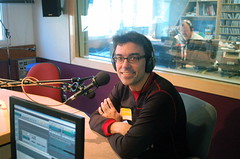 For the first time in almost a year and a half, I'll be appearing on CBC Radio Vancouver's On the Coast afternoon drive-time show to talk about my ongoing cancer treatment, this time with new host Stephen Quinn.
For the first time in almost a year and a half, I'll be appearing on CBC Radio Vancouver's On the Coast afternoon drive-time show to talk about my ongoing cancer treatment, this time with new host Stephen Quinn.I'm recording the interview this morning, but it will go to air later this afternoon—I'll update this post once I find out precisely when. If you're not in broadcast range of CBC Vancouver in southwestern B.C. (690 AM in Vancouver, also currently experimentally at 88.1 FM), you can listen to the high bandwidth or low bandwidth Windows Media stream (Mac users can use the free Flip4Mac plugin).
UPDATE: My interview, recorded before lunchtime this morning, will be broadcast just after the 5 o'clock news today, around 5:10 p.m.
I'll do my best to post the audio to my podcast afterwards as well. You might also want to listen to a related interview I gave to the national CBC Radio show Spark this last spring, which was rebroadcast just a few weeks ago too.05 November 2008
Non-killer packaging
Amazon's new frustration-free packaging (via Gruber and Kottke) is a great idea—plus I was surprised and pleased to find that Wired's coverage of the announcement includes one of my photos:
04 November 2008
President Obama
 Back in February, I wrote:
Back in February, I wrote:America and the rest of us need inspiration now. America's citizens need to say to us, and to themselves, "We have been on the wrong path, and we will choose a different and better way." To see and to listen to Barack Obama as president will demonstrate the beginning of that choice. If I'm right, I think he will win.And so it is. I'm glad I wasn't wrong. Thank you for your choice, citizens of the United States of America.
Still waiting on news about Proposition 8. Fingers crossed.
03 November 2008
Links of interest (2008-11-03):
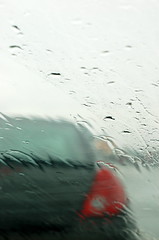
- “[Obama] said he likes to go out trick-or-treating, but he can’t anymore. [...] He said he guessed he could have worn a Barack Obama mask.”
- America contains a strange dichotomy about teenage sex: "Social liberals in the country's 'blue states' tend to support sex education and are not particularly troubled by the idea that many teen-agers have sex before marriage, but would regard a teen-age daughter's pregnancy as devastating news. And the social conservatives in 'red states' generally advocate abstinence-only education and denounce sex before marriage, but are relatively unruffled if a teen-ager becomes pregnant, as long as she doesn't choose to have an abortion."
- From the same post at The Slog, back in 1970 Aretha Franklin sang and played piano in a lesson in soul that today's diva singers could still learn a thing or two (or twenty) from. In particular, her melisma (one syllable, many notes) is hardly noticeable, because she uses it sparingly and for (perhaps instinctive) emotional emphasis, rather than as a special effect. Maya Rudolph nailed it in this SNL satire in 2006 (sorry for the lousy audio, but you'll get it).
- Darren, who never adds salt or pepper to a prepared meal, wonders why so many of us do, even before we taste it. Shouldn't food, he asks, be properly seasoned before it arrives?
- Lisa has some good tips for photography on rainy days (also at TWIP)—especially useful right now in Vancouver.
- It's inevitable that an article (via Pharyngula) about an estranged son of the despicable Fred Phelps and his Westboro Baptist Church provokes a nasty flame war in the comments, but to have Phelps's equally vitriolic daughter Shirley (who obviously keeps up regular ego-surfing) be the first to comment brings it to a new level. Nice work by The Ubyssey, by the way—their journalism and copy editing seem to have improved since my days at UBC a couple of decades ago.
02 November 2008
Our neck of the woods
Most of the trees up here in the Pacific Northwest of North
America are conifers, so we don't get the full richness of autumn
colours from changing leaves. But sometimes the deciduous trees we do
have are still pretty awesome:
The air was clear after much rain earlier, so the colours were particularly vibrant. My HDR treatment on the image helps too—but it's still pretty close to how it looked out our front window this afternoon.
The air was clear after much rain earlier, so the colours were particularly vibrant. My HDR treatment on the image helps too—but it's still pretty close to how it looked out our front window this afternoon.


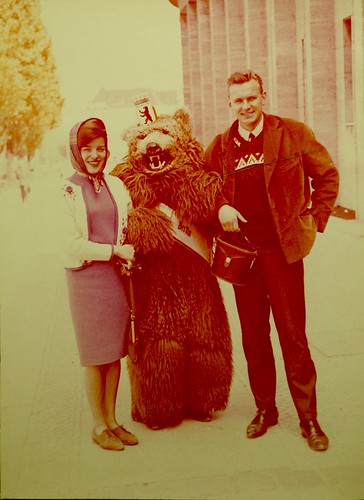
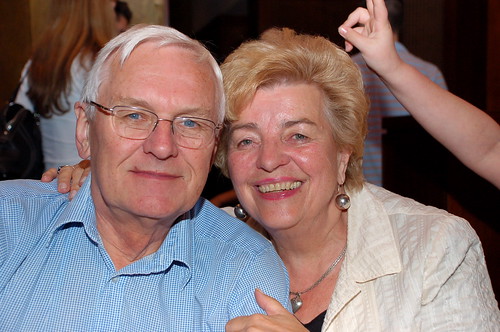
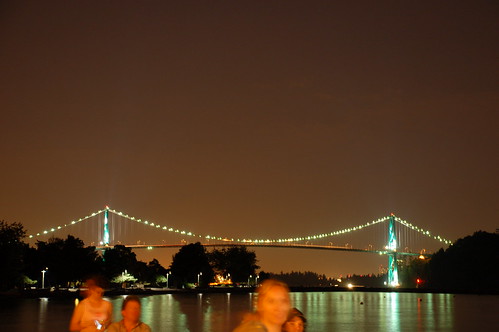

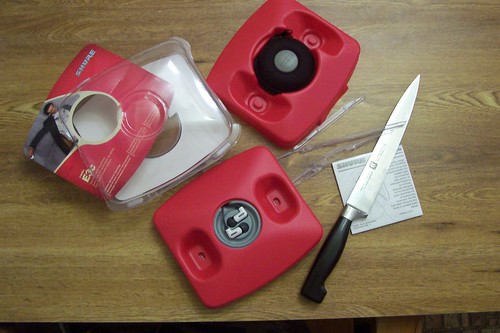
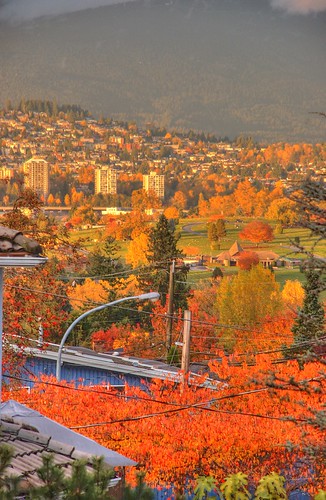
No comments:
Post a Comment